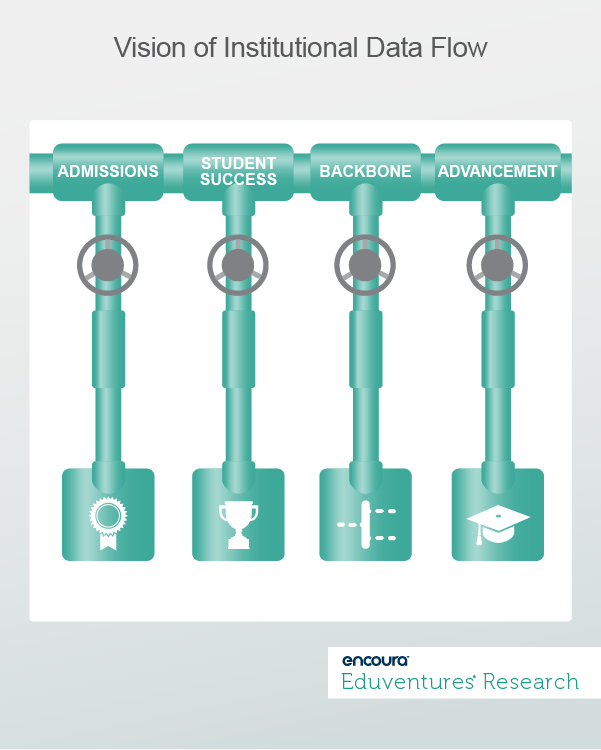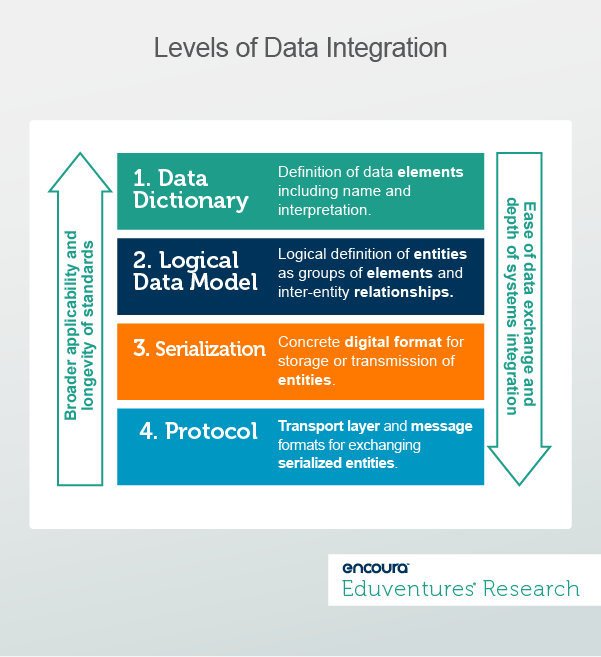Most conversations about integration hinge on the belief that technology solutions, once integrated, will share a data flow seamlessly so that users can access and use all data held within the integrated products. Unfortunately, this belief conflates data shareability with data usability. Many solutions, such as the system integration solutions included in our Technology Landscape, prioritize shareability, but few account for system-wide usability.
At its recent annual conference, Blackboard announced the launch of a new product, Blackboard Data, which promises to help institutions achieve data flow usability. Will it?
Data flow between technology products generally begins with the creation of integration pipes—called “application programming interfaces” (APIs), through which data from each system flows (Figure 1). The creation of APIs achieves this data flow on its own.
To empower users with useful access to data from different solutions, however, systems must also share the same meaning and structure. Known in the healthcare industry as “semantic interoperability,” this shared meaning and structure ensures that two or more systems exchange information and that users can interpret and use that information.

While positioned as an analytics and reporting tool, the true differentiator of Blackboard’s new product is its attempt to crack this data flow issue and help institutions achieve semantic interoperability across a learning ecosystem. But to assess the potential effectiveness of Blackboard Data, a deeper understanding of semantic interoperability is necessary.
What is Semantic Interoperability?
As shown in Figure 2, full integration involves four layers: protocol, serialization, data models, and a data dictionary. Most integration approaches focus on the bottom two layers, stressing how APIs and other integration can help achieve the method and format of data transfer.
What is missing from these approaches is the meaning and structure of the data. For example, one institution might find that the meaning of a simple term, such as “school,” differs across different solutions or that one solution accepts that a person might be both a student and an alumna while another solution does not. As a result, despite the different solutions sharing the same data, users find that the data they receive is confusing or incorrect.

The most common approach to ensuring a foundation for semantic interoperability is to create data models, which capture what each data element means and depicts the real world relationships between them. In higher education specifically, there are several models, ranging from vendor-agnostic models, such as the Common Education Data Standards (CEDS), the Unizin Data Model, and the Postsecondary Electronic Standards Council (PESC) to vendor-specific ones, like Salesforce’s Education Data Architecture (EDA) and Ellucian’s Ethos Data Platform.
How does Blackboard Data Help?
Blackboard Data is a promising effort to enable the data flow across a learning ecosystem. Its data model allows integration to occur within the context of a shared meaning and structure. Also, Blackboard Data helps institutions gain insight into the quality of their data by granting visibility into gaps between data needed to inform teaching and learning and their current data.
Given this, we think Blackboard Data bears consideration by institutions that want a data platform to underpin their teaching and learning ecosystems and improve the flow of meaningful data to different stakeholders. In addition, here are three other takeaways:
- Intended use as an integrated horizontal across vertical products. As we wrote in a previous Wake-Up Call about Oracle, vendors find it challenging to integrate horizontal functionality, such as databases, into their vertical products designed to address specific industries and needs. Here, Blackboard is already surfacing the functionality of Blackboard Data into its other products, like Blackboard Learn.
- Potential as an open platform. Earlier this month, we wrote a Wake-Up Call on the value of open platforms, i.e., those solutions that enable the development, addition, and support of functionality, but also allow both producers (vendors) and consumers (users) to do so. In our discussions with Blackboard, we discovered that the long-term vision is to have Blackboard Data serve as such a platform, allowing developers to create apps that consume the data contained within it.
- Evidence of improved product management. Two years ago, we highlighted a shift in how Blackboard was changing its entire product development strategy to become more responsive and nimble. We see the one-year development and launch of Blackboard Data as evidence that the change is bearing fruit—Blackboard seems to be in a much better position to move from ideation or recognizing stakeholder needs to release new products or new product functionality.
With its new product, . We look forward to tracking the progress of Blackboard Data and exploring its impact within higher education.
Thursday, August 29, 2019 at 2PM ET/1PM CT
Much has been said about the characteristics and preferences of Gen Z, but new Eduventures research unveils that vast differences exist even within this generation. From distinct search strategies to micro-generational behaviors and attitudes, recruitment outreach needs to be more personalized than ever. Learn which outreach strategies help your marketing team engage the right students at the right time, and understand what many students wish colleges and universities got right.
Thank you for subscribing!
Thank you for subscribing!

